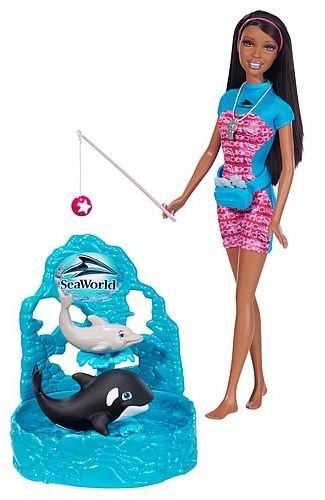Source (Google.com.pk)
Download Barbies Wallpaper Biography
Mattel feared that Barbie's image was too perfect so they decided to create a more personal side of Barbie making her appear more like a real person. Society's emphasis was on a strong nuclear family, therefore in the 60's Barbie's parents were identified as Robert and Margareth Roberts from Willows, Wisconsin (Kehoe "Barbie"). Along with parents, Mattel developed a boyfriend and female friend for Barbie. Ken, named after the Handler's son, was introduced in 1961, and Midge, Barbie's freckle faced friend, debuted in 1963 (See Figures 4 and 5).
Because of Barbie's lack of a family, her first relation was a male companion named Ken. The first advertisement for Ken said, "He's a doll!" (BillyBoy 40). Barbie's boyfriend was given an image of "innocence, cleanliness, extroverted playfulness, boyish masculinity, and a hint of shyness" (BillyBoy 40). To accompany this image, Ken came with teenage male essentials, such as a letter sweater, tuxedo, and a gray flannel suit. One of the biggest questions facing Mattel was how anatomically correct should Ken be. They finally determined that young girls did not need to be exposed to some realities of adulthood; therefore Ken was born with permanent underwear.
Ken's development portrays one of the expectations of 1950's women. It was necessary to create Ken because "women were considered failures without male companionship" (Johnson "Barbie's Effects on American Suburban Culture").
All propaganda involving Barbie and Ken portray them as the stereotypical teenage couple. The first television commercial for Ken takes place at a ball. Amid this romantic scene, Barbie spots Ken, and it's love at first sight. All of the ads for Barbie and her "handsome steady" are a reflection of the innocent qualities of courtship (Weiss "Toys Were Us"). Ken and Barbie had coordinating outfits for the "beach, fraternity dances, after-school sodas, etc" (BillyBoy 41). A magazine about Barbie and Ken's adventures was published. Barbie and Ken were seen as being so much in love that they could not go anywhere without each other (as seen in Figure 3). After Barbie helps Ken in the garden, she says, "I'd do it any time Ken, just so long as we're together" (BillyBoy 42). Compared to modern culture, this is an extremely cordial and sappy relationship. The Barbie and Ken comic book furthers the portrayal of male and female relations of the early 1960's before the hippie culture invaded.









Download Barbies Wallpaper Biography
Mattel feared that Barbie's image was too perfect so they decided to create a more personal side of Barbie making her appear more like a real person. Society's emphasis was on a strong nuclear family, therefore in the 60's Barbie's parents were identified as Robert and Margareth Roberts from Willows, Wisconsin (Kehoe "Barbie"). Along with parents, Mattel developed a boyfriend and female friend for Barbie. Ken, named after the Handler's son, was introduced in 1961, and Midge, Barbie's freckle faced friend, debuted in 1963 (See Figures 4 and 5).
Because of Barbie's lack of a family, her first relation was a male companion named Ken. The first advertisement for Ken said, "He's a doll!" (BillyBoy 40). Barbie's boyfriend was given an image of "innocence, cleanliness, extroverted playfulness, boyish masculinity, and a hint of shyness" (BillyBoy 40). To accompany this image, Ken came with teenage male essentials, such as a letter sweater, tuxedo, and a gray flannel suit. One of the biggest questions facing Mattel was how anatomically correct should Ken be. They finally determined that young girls did not need to be exposed to some realities of adulthood; therefore Ken was born with permanent underwear.
Ken's development portrays one of the expectations of 1950's women. It was necessary to create Ken because "women were considered failures without male companionship" (Johnson "Barbie's Effects on American Suburban Culture").
All propaganda involving Barbie and Ken portray them as the stereotypical teenage couple. The first television commercial for Ken takes place at a ball. Amid this romantic scene, Barbie spots Ken, and it's love at first sight. All of the ads for Barbie and her "handsome steady" are a reflection of the innocent qualities of courtship (Weiss "Toys Were Us"). Ken and Barbie had coordinating outfits for the "beach, fraternity dances, after-school sodas, etc" (BillyBoy 41). A magazine about Barbie and Ken's adventures was published. Barbie and Ken were seen as being so much in love that they could not go anywhere without each other (as seen in Figure 3). After Barbie helps Ken in the garden, she says, "I'd do it any time Ken, just so long as we're together" (BillyBoy 42). Compared to modern culture, this is an extremely cordial and sappy relationship. The Barbie and Ken comic book furthers the portrayal of male and female relations of the early 1960's before the hippie culture invaded.
Download Barbies Wallpaper

Download Barbies Wallpaper

Download Barbies Wallpaper

Download Barbies Wallpaper

Download Barbies Wallpaper

Download Barbies Wallpaper

Download Barbies Wallpaper

Download Barbies Wallpaper

Download Barbies Wallpaper
Download Barbies Wallpaper

Download Barbies Wallpaper

No comments:
Post a Comment